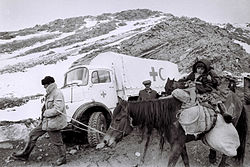Refugees from Armenia

According to the 1979 census, Azeris numbered 160,841 and constituted 5.3% of Armenia's population. [2] Civil unrest in Nagorno-Karabakh in 1987 led to Azeris' being often harassed and forced to leave Armenia. [3] On 25 January 1988, the first wave of Azeri refugees from Armenia settled in the city of Sumgait. [3] [4] Another major wave occurred in November 1988 [4] as Azeris were either expelled by the nationalists and local or state authorities [5] or fled fearing for their lives. [6] Violence took place as a result of ethnic conflicts; [7] in November 1988, 25 Azeris were killed, according to Armenian sources (of those 20 in the town of Gugark during the Gugark pogrom); [8] and 217, according to Azerbaijani sources. [9]
Thus, in 1988–91 the remaining Azeris were forced to flee primarily to Azerbaijan. [5] [10] [11] It is impossible to determine the exact population numbers for Azeris in Armenia at the time of the conflict's escalation since the 1989 census forced Azeri migration from Armenia was already in progress. UNHCR's estimate is 200,000 persons. [6]
According to the Azerbaijani government at the time of the ceasefire in 1994 there were about 250,000 Azeri refugees from Armenia. [12] According to the 1998 Citizenship Law they are all eligible for citizenship. By the end of 2001, UNHCR estimated that most of them were believed to have naturalized or be in the process of doing so. [13]



























